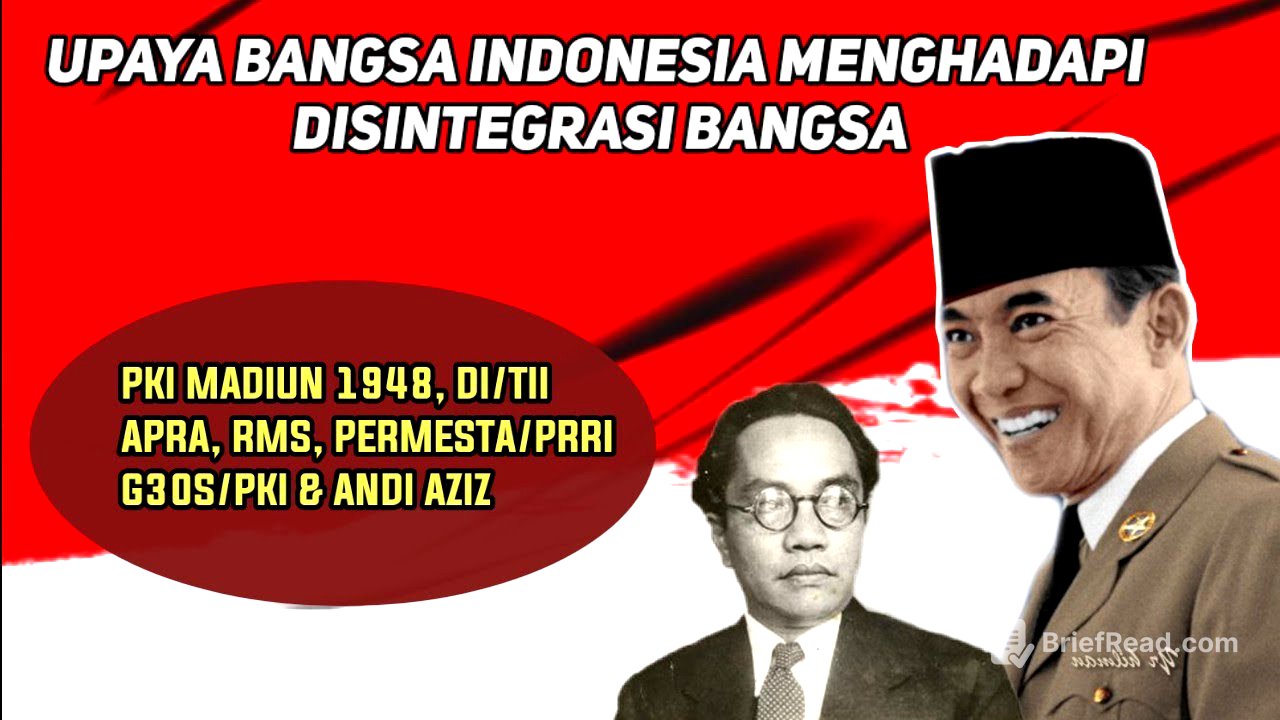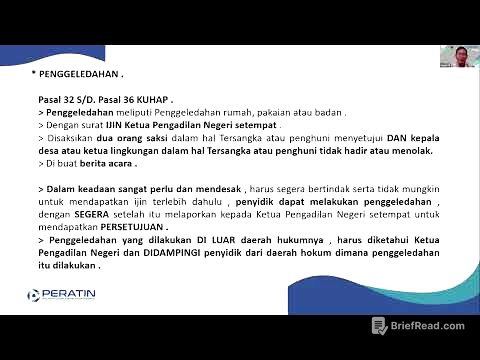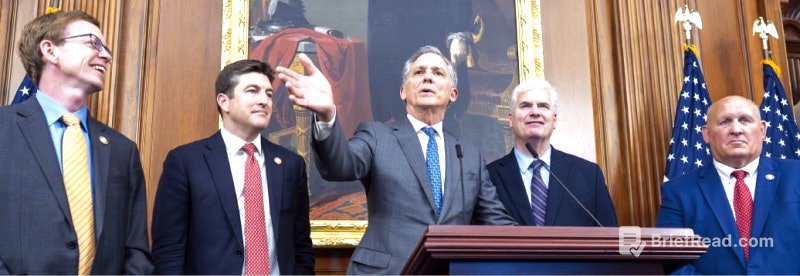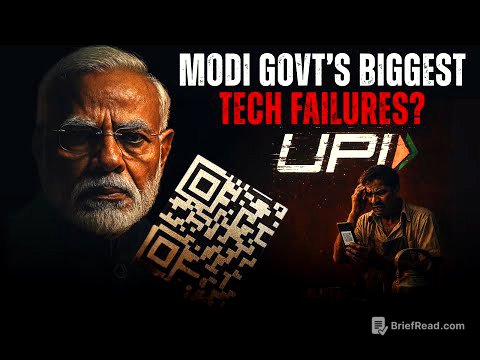TLDR;
This video discusses national disintegration in Indonesia, which refers to the process of separation or division that threatens the unity of the nation. It categorizes rebellions into three types: those related to ideology (like the PKI Madiun rebellion and G30S PKI), those related to interests (such as PRRI/Permesta), and those related to military issues (like the Andi Azis rebellion and the Republic of South Maluku). The video then explains the background, events, and outcomes of several key rebellions and movements that aimed to destabilize or divide Indonesia.
- National disintegration involves separation or division threatening national unity.
- Rebellions categorized by ideology, interests, and military issues.
- Key events discussed: PKI Madiun, DI/TII, G30S PKI, PRRI/Permesta, Andi Azis, RMS, and APRA.
Introduction to National Disintegration [0:00]
The video introduces the concept of national disintegration, defining it as the opposite of integration. Integration is described as the process of uniting diverse elements within a society into a unified nation. National disintegration, therefore, involves the separation or division of a nation. The presenter notes that rebellions in Indonesia are classified into three categories: those related to ideology, interests, and military issues.
PKI Madiun Rebellion (1948) [1:31]
The PKI Madiun rebellion in 1948 was initiated by the PKI, which was initially known as ISDV founded in 1914, in collaboration with the FDR (a united front of left-wing parties established by Amir Syarifudin in February 1948). The rebellion was triggered by the fall of the Amir Syarifudin Cabinet, which represented Indonesia in the Renville Agreement. This agreement led to public disappointment due to the shrinking of Indonesian territory. The PKI incited demonstrations and strikes by workers and farmers. Muso, an opposition figure, criticized the government, endangering Indonesia's diplomatic strategy against the Netherlands. The rebellion culminated in an armed uprising on September 18, 1948, in Madiun, with the proclamation of the Republic of Soviet Indonesia and the formation of a new government. The government responded with military action, and after failed diplomatic efforts, the rebellion was crushed by Siliwangi troops. Muso was shot, and Amir Sjarifuddin was sentenced to death.
DI/TII Rebellion [3:28]
The DI/TII (Darul Islam/Tentara Islam Indonesia) rebellion aimed to establish an Islamic state in Indonesia. The first DI/TII rebellion occurred in West Java, led by Sekarmadji Maridjan Kartosuwiryo. The background was Kartosuwiryo's disappointment with the Renville Agreement, which required the TNI to evacuate areas controlled by the Dutch. Kartosuwiryo refused to cede West Java and proclaimed the Islamic State of Indonesia on August 17, 1945. The government launched Operasi Baratayuda with the "fence of legs" tactic to suppress the rebellion. Kartosuwiryo and his followers were captured by Siliwangi troops on Mount Geber in West Java on June 4, 1962.
DI/TII Central Java [4:44]
In Central Java, the DI/TII rebellion was led by Amir Fatah and Kyai Somalangu. Amir Fatah proclaimed DI/TII and joined Kartosuwiryo on August 23, 1949. The rebellion in Central Java was crushed in 1957 through a military operation known as the Banteng Raiders operation by the Diponegoro Division.
DI/TII South Sulawesi [5:15]
The DI/TII rebellion in South Sulawesi was led by Kahar Muzakkar, stemming from disharmony and Muzakkar's request to integrate his guerrilla unit into the TNI. His demand was rejected, leading to his rebellion.
DI/TII Aceh [5:45]
In Aceh, the DI/TII rebellion was led by Daud Beureuh, triggered by the reduction of Aceh's status from a special region to a residency under North Sumatra. On September 21, 1953, Daud Beureuh declared Aceh part of Kartosuwiryo's NII. The rebellion was eventually suppressed through a deliberation on harmony among the Acehnese people on December 17-28, 1963.
DI/TII South Kalimantan [6:20]
The DI/TII rebellion in South Kalimantan was led by Ibnu Hajar (alias Haderi bin Umar). In 1954, Ibnu Hajar was appointed as commander of TII South Kalimantan. The government successfully captured Ibnu Hajar on March 22, 1965, and sentenced him to death.
G30S PKI Movement [6:47]
The G30S PKI movement aimed to overthrow President Soekarno's government and transform Indonesia into a communist state. Led by D.N. Aidit, the chairman of the PKI, the coup was launched on October 1, 1965, under the leadership of Lieutenant Colonel Untung. The movement targeted army officers considered obstacles to the PKI's goals, kidnapping and murdering them in the Lubang Buaya area. The rebellion also occurred in Yogyakarta. Six high-ranking officers, including Lieutenant General Ahmad Yani and Major General Soeprapto, were among the victims, later named Heroes of the Revolution. The operation to crush the G30S PKI was swiftly carried out under the leadership of Major General Soeharto. Lieutenant Colonel Untung was captured in the Tegal area of Central Java.
PRRI/Permesta Rebellion [8:42]
The PRRI (Pemerintah Revolusioner Republik Indonesia) and Permesta (Perjuangan Rakyat Semesta) rebellions occurred after the recognition of sovereignty from the Netherlands. The background was the central government's perceived unfairness in distributing development funds to civilians and the military. Regional councils were formed, including the Banteng Council led by Lieutenant Colonel Ahmad Husein, the Gajah Council led by Colonel Maluddin Simbolon, the Garuda Council led by Lieutenant Colonel Barlian, and the Manguni Council led by Colonel Ventje Sumual. Lieutenant Colonel Ventje Sumual proclaimed Permesta on March 2, 1957, and Ahmad Husein proclaimed PRRI on February 15, 1958. Ahmad Husein issued an ultimatum to the government to hand over its mandate to President Soekarno, who was to assign Hatta and Sri Sultan Hamengkubuwono IX to form a national cabinet. The government rejected the ultimatum and considered the movement a rebellion. Operation 17 August, led by Ahmad Yani, was launched to crush the PRRI, and Ahmad Husein was captured. Permesta was crushed by Operation Merdeka under Colonel Rukminto Hendraningrat. Evidence of foreign involvement, including a U.S. plane piloted by Allen Pope, was discovered during the operation.
Andi Azis Rebellion [10:46]
The Andi Azis rebellion occurred in Makassar in 1950, led by Andi Azis, a former KNIL officer. The background was Andi Azis's desire to defend the State of East Indonesia and his rejection of the TNI's entry into the region. On April 5, 1950, Andi Azis's troops attacked the TNI headquarters in Makassar. The government ordered Andi Azis to report to Jakarta within four times 24 hours to take responsibility for his actions. A military operation was launched in South Sulawesi on April 15, 1984. Andi Azis initially fled to Jakarta but was later arrested and detained on August 5, 1950.
Republic of South Maluku (RMS) Rebellion [12:21]
The Republic of South Maluku (RMS) rebellion was masterminded by Dr. Soumokil, the former Attorney General of the State of East Indonesia, with the aim of separating Maluku from the Republic of Indonesia. On April 25, 1950, Dr. Soumokil proclaimed the Republic of South Maluku, with J. Manahutu as its president, later replaced by Soumokil. The RMS Armed Forces (APMS) were formed under the leadership of D.J. Samson. The government's efforts to suppress the RMS included a peace request through Dr. Jelly Bean, which was rejected by Dr. Soumokil. A military expedition led by Colonel A.E. Kawilarang was launched, and Ambon City was controlled in November 1950. Dr. Soumokil was captured and sentenced to death.
APRA Rebellion [13:37]
The APRA (Angkatan Perang Ratu Adil) rebellion in 1949 was led by Captain Raymond Westerling. The goals were to disrupt the recognition of sovereignty from the Dutch kingdom to Indonesia and to maintain the federal state of Indonesia and the existence of the APRA army. Westerling contacted Lieutenant General Buurman van Veen and planned a coup against Soekarno. On January 5, 1950, Westerling demanded that the government respect the states, namely the State of Pasundan, and recognize APRA as its soldiers. On January 10, 1950, Hatta ordered action against Westerling. APRA attacked Bandung City, resulting in casualties. Westerling planned the assassination of Sri Sultan Hamengkubuwono IX and T.B. Simatupang. Westerling fled abroad on February 22, 1958, aboard a Dutch Navy Catalina aircraft.









